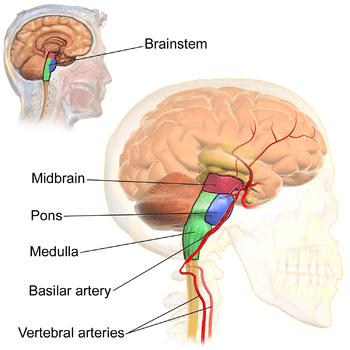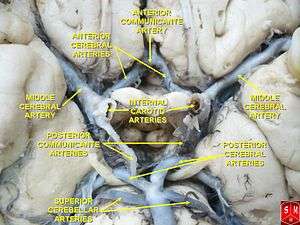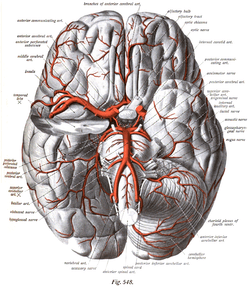Basilar artery
The basilar artery is one of the arteries that supplies the brain with oxygen-rich blood.
| Basilar artery | |
|---|---|
 The basilar artery lies at the front of the brainstem in the midline and is formed from the union of the two vertebral arteries. | |
 The basilar artery terminates by splitting into the left and right posterior cerebral arteries. | |
| Details | |
| Source | Vertebral arteries |
| Branches | Pontine arteries, anterior inferior cerebellar (AICA) and superior cerebellar arteries, and terminal posterior cerebral arteries. |
| Supplies | Pons, and superior and inferior aspects of the cerebellum. |
| Identifiers | |
| Latin | Arteria basilaris |
| MeSH | D001488 |
| TA | A12.2.07.081 |
| FMA | 50542 |
| Anatomical terminology | |
The two vertebral arteries and the basilar artery are sometimes together called the vertebrobasilar system, which supplies blood to the posterior part of the circle of Willis and joins with blood supplied to the anterior part of the circle of Willis from the internal carotid arteries.
Structure
The basilar artery arises from the union of the two vertebral arteries at the junction between the medulla oblongata and the pons between the abducens nerves (CN VI).[1]
It ascends superiorly in the basilar sulcus of the ventral pons and divides at the junction of the midbrain and pons into the posterior cerebral arteries.
Its branches from caudal to rostral include:
- anterior inferior cerebellar artery
- labyrinthine artery (<15% of people, usually branches from the anterior inferior cerebellar artery)
- pontine arteries
- superior cerebellar artery
Clinical relevance
A basilar artery stroke classically leads to locked-in syndrome.
Additional images
 The internal carotid and vertebral arteries (Right side view)
The internal carotid and vertebral arteries (Right side view) Basilar artery
Basilar artery The arteries of the base of the brain. Basilar artery labeled below center. The temporal pole of the cerebrum and the cerebellar hemisphere have been removed on the right side. Inferior aspect (viewed from below).
The arteries of the base of the brain. Basilar artery labeled below center. The temporal pole of the cerebrum and the cerebellar hemisphere have been removed on the right side. Inferior aspect (viewed from below).
References
- Byrne, James (2012). "Chapter 2. Cranial arterial anatomy". Tutorials in endovascular neurosurgery and interventional neuroradiology. Berlin: Springer. pp. 37–38.
External links
| Wikimedia Commons has media related to Arteria basilaris. |
- Basilar Artery at neuroangio.org
- Anatomy photo:28:09-0204 at the SUNY Downstate Medical Center - "Cranial Fossae: Arteries, Inferior Surface of the Brain"
- Blood supply at neuropat.dote.hu
- "Anatomy diagram: 13048.000-1". Roche Lexicon - illustrated navigator. Elsevier. Archived from the original on 2014-01-01.
- "Anatomy diagram: 13048.000-3". Roche Lexicon - illustrated navigator. Elsevier. Archived from the original on 2014-01-01.